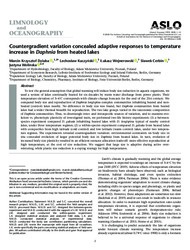Countergradient variation concealed adaptive responses to temperature increase in Daphnia from heated lakes
Dziuba, Marcin Krzysztof; Kuczyński, Lechosław; Wejnerowski, Łukasz; Cerbin, Slawek; Wolinska, Justyna, 2020: Countergradient variation concealed adaptive responses to temperature increase in Daphnia from heated lakes. In: Limnology and Oceanography, DOI: 10.23689/fidgeo-4225.
 |
Dokument öffnen: |
To test the general assumption that global warming will induce body size reduction in aquatic organisms, we used a system of lakes continually heated for six decades by warm water discharge from power plants. Their temperature elevation of 3–4°C corresponds with climate change forecasts for the end of the 21st century. We compared body size and reproduction of Daphnia longispina complex communities inhabiting heated and non‐heated (control) lakes nearby. No difference in body size was found, but Daphnia communities from heated lakes had a wider thermal breadth for reproduction. The two lake groups varied in the taxonomic composition of Daphnia communities. Thus, to disentangle inter‐ and intraspecific sources of variation, and to examine evolution vs. phenotypic plasticity of investigated traits, we performed two life history experiments: (1) a between‐species experiment compared D. galeata inhabiting heated lakes with D. longispina typical of nearby control lakes, under three temperature regimes; (2) a within‐species experiment compared D. galeata from heated lakes with conspecifics from high latitude (cold control) and low latitude (warm control) lakes, under two temperature regimes. The experiments revealed countergradient variation: environmental constraints on body size in situ concealed evolution of larger potential body size in Daphnia from heated lakes. In turn, evolution of increased body size plasticity resulted in an efficient resource allocation trade‐off: more effective reproduction at high temperature, at the cost of size reduction. We suggest that large size is adaptive during active overwintering, while plastic size reduction is a coping strategy for high temperatures.
Statistik:
ZugriffsstatistikSammlung:
This is an open access article under the terms of the Creative Commons Attribution‐NonCommercial‐NoDerivs License, which permits use and distribution in any medium, provided the original work is properly cited, the use is non‐commercial and no modifications or adaptations are made.

